SWOT Analysis of Tea Festival in Singapore
VerifiedAdded on 2023/06/07
|6
|1281
|196
AI Summary
This article provides a SWOT analysis of the Tea Festival in Singapore, considering the event's strengths, weaknesses, opportunities, and threats. The analysis highlights the event's cultural significance, location, and use of technology to attract visitors.
Contribute Materials
Your contribution can guide someone’s learning journey. Share your
documents today.
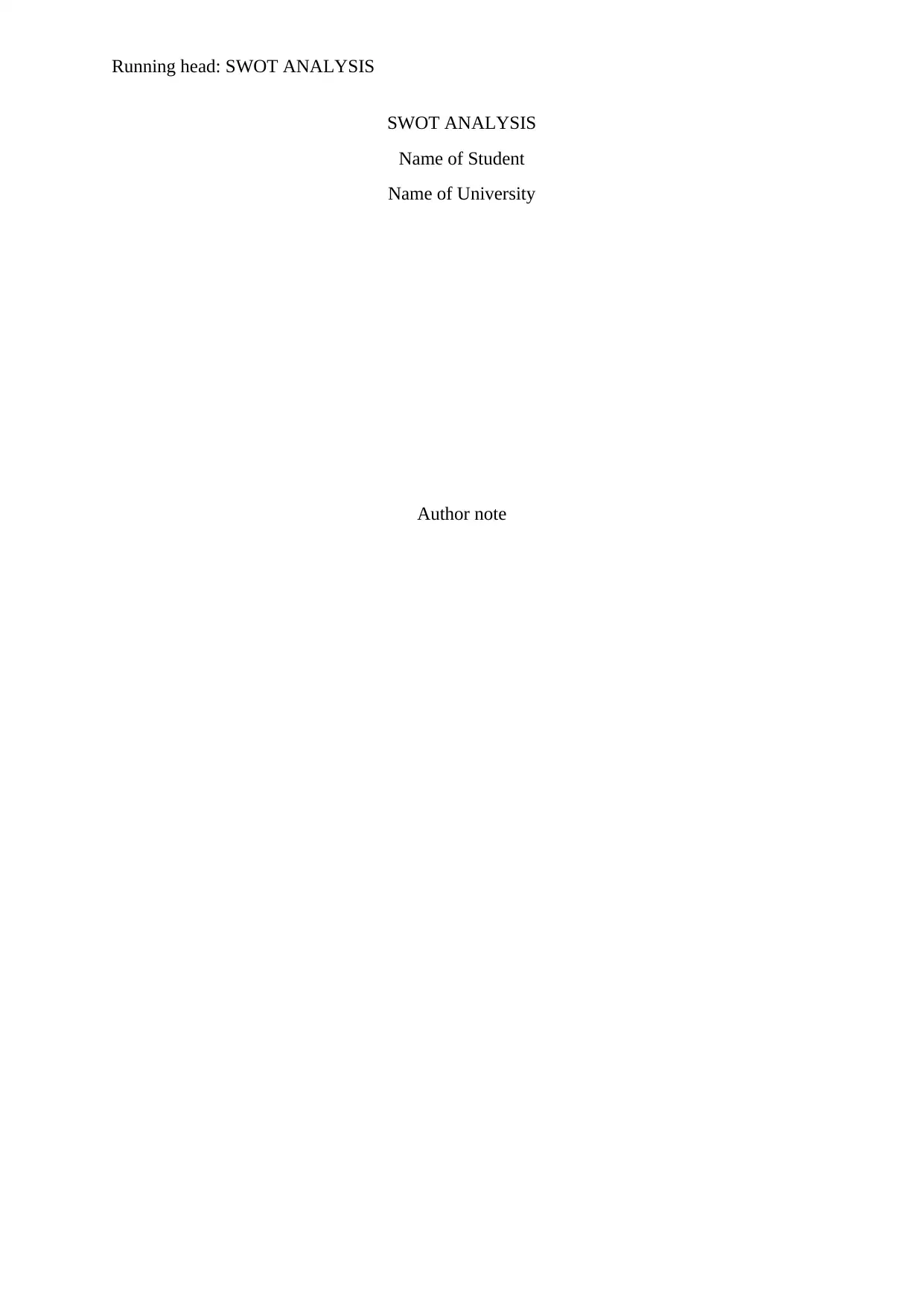
Running head: SWOT ANALYSIS
SWOT ANALYSIS
Name of Student
Name of University
Author note
SWOT ANALYSIS
Name of Student
Name of University
Author note
Secure Best Marks with AI Grader
Need help grading? Try our AI Grader for instant feedback on your assignments.
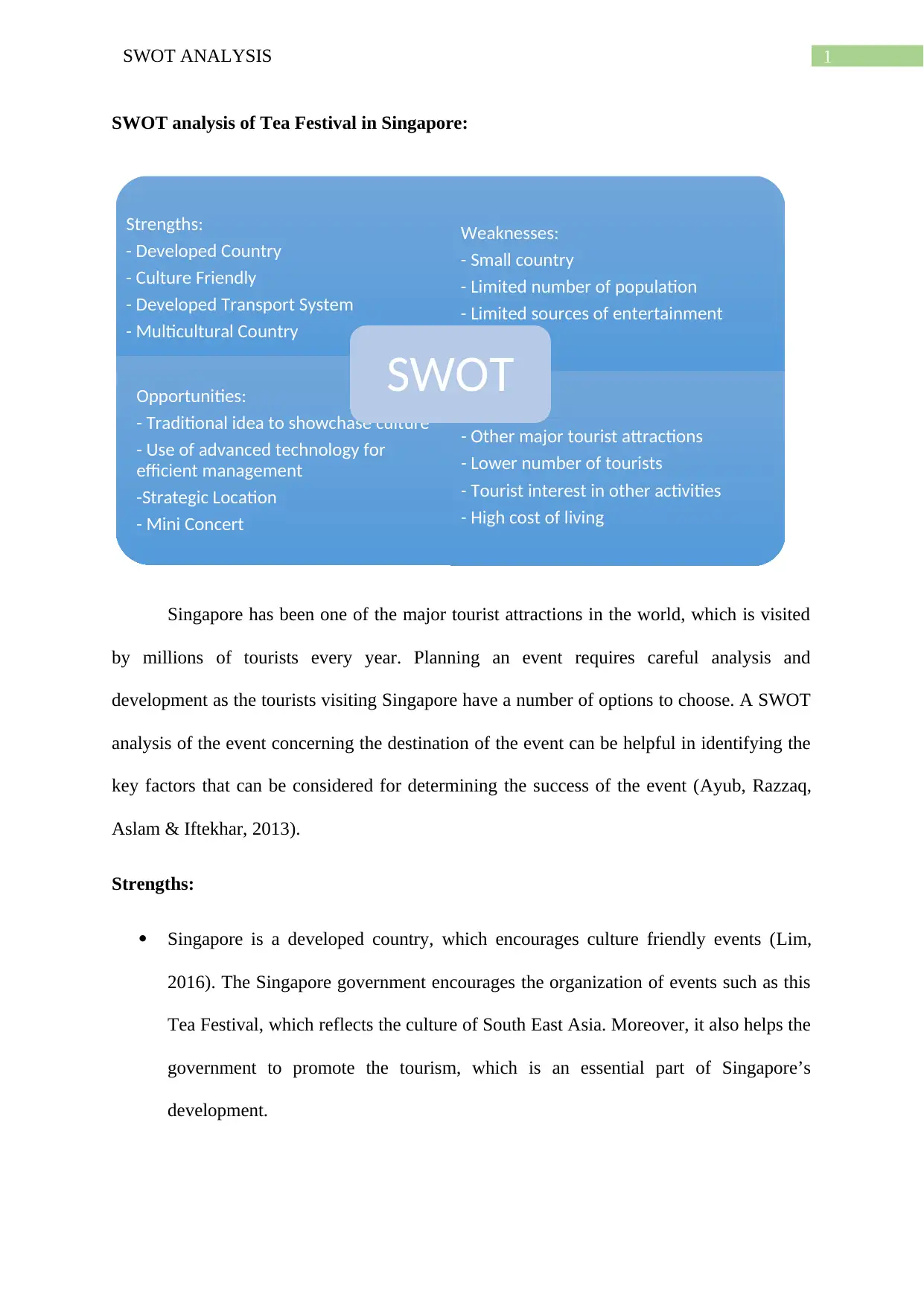
1SWOT ANALYSIS
SWOT analysis of Tea Festival in Singapore:
Singapore has been one of the major tourist attractions in the world, which is visited
by millions of tourists every year. Planning an event requires careful analysis and
development as the tourists visiting Singapore have a number of options to choose. A SWOT
analysis of the event concerning the destination of the event can be helpful in identifying the
key factors that can be considered for determining the success of the event (Ayub, Razzaq,
Aslam & Iftekhar, 2013).
Strengths:
Singapore is a developed country, which encourages culture friendly events (Lim,
2016). The Singapore government encourages the organization of events such as this
Tea Festival, which reflects the culture of South East Asia. Moreover, it also helps the
government to promote the tourism, which is an essential part of Singapore’s
development.
Strengths:
- Developed Country
- Culture Friendly
- Developed Transport System
- Multicultural Country
Weaknesses:
- Small country
- Limited number of population
- Limited sources of entertainment
Opportunities:
- Traditional idea to showchase culture
- Use of advanced technology for
efficient management
-Strategic Location
- Mini Concert
Threats:
- Other major tourist attractions
- Lower number of tourists
- Tourist interest in other activities
- High cost of living
SWOT
SWOT analysis of Tea Festival in Singapore:
Singapore has been one of the major tourist attractions in the world, which is visited
by millions of tourists every year. Planning an event requires careful analysis and
development as the tourists visiting Singapore have a number of options to choose. A SWOT
analysis of the event concerning the destination of the event can be helpful in identifying the
key factors that can be considered for determining the success of the event (Ayub, Razzaq,
Aslam & Iftekhar, 2013).
Strengths:
Singapore is a developed country, which encourages culture friendly events (Lim,
2016). The Singapore government encourages the organization of events such as this
Tea Festival, which reflects the culture of South East Asia. Moreover, it also helps the
government to promote the tourism, which is an essential part of Singapore’s
development.
Strengths:
- Developed Country
- Culture Friendly
- Developed Transport System
- Multicultural Country
Weaknesses:
- Small country
- Limited number of population
- Limited sources of entertainment
Opportunities:
- Traditional idea to showchase culture
- Use of advanced technology for
efficient management
-Strategic Location
- Mini Concert
Threats:
- Other major tourist attractions
- Lower number of tourists
- Tourist interest in other activities
- High cost of living
SWOT
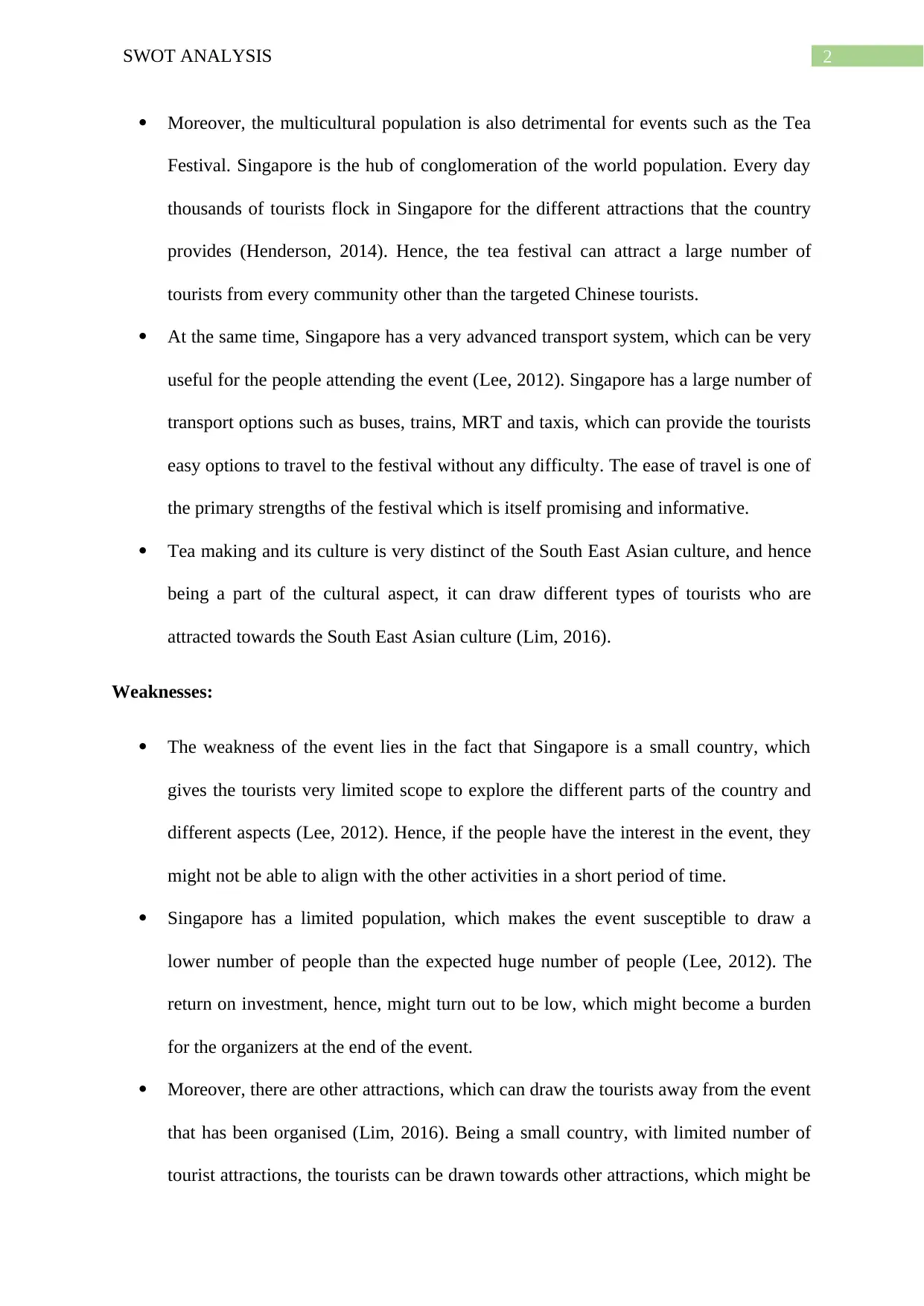
2SWOT ANALYSIS
Moreover, the multicultural population is also detrimental for events such as the Tea
Festival. Singapore is the hub of conglomeration of the world population. Every day
thousands of tourists flock in Singapore for the different attractions that the country
provides (Henderson, 2014). Hence, the tea festival can attract a large number of
tourists from every community other than the targeted Chinese tourists.
At the same time, Singapore has a very advanced transport system, which can be very
useful for the people attending the event (Lee, 2012). Singapore has a large number of
transport options such as buses, trains, MRT and taxis, which can provide the tourists
easy options to travel to the festival without any difficulty. The ease of travel is one of
the primary strengths of the festival which is itself promising and informative.
Tea making and its culture is very distinct of the South East Asian culture, and hence
being a part of the cultural aspect, it can draw different types of tourists who are
attracted towards the South East Asian culture (Lim, 2016).
Weaknesses:
The weakness of the event lies in the fact that Singapore is a small country, which
gives the tourists very limited scope to explore the different parts of the country and
different aspects (Lee, 2012). Hence, if the people have the interest in the event, they
might not be able to align with the other activities in a short period of time.
Singapore has a limited population, which makes the event susceptible to draw a
lower number of people than the expected huge number of people (Lee, 2012). The
return on investment, hence, might turn out to be low, which might become a burden
for the organizers at the end of the event.
Moreover, there are other attractions, which can draw the tourists away from the event
that has been organised (Lim, 2016). Being a small country, with limited number of
tourist attractions, the tourists can be drawn towards other attractions, which might be
Moreover, the multicultural population is also detrimental for events such as the Tea
Festival. Singapore is the hub of conglomeration of the world population. Every day
thousands of tourists flock in Singapore for the different attractions that the country
provides (Henderson, 2014). Hence, the tea festival can attract a large number of
tourists from every community other than the targeted Chinese tourists.
At the same time, Singapore has a very advanced transport system, which can be very
useful for the people attending the event (Lee, 2012). Singapore has a large number of
transport options such as buses, trains, MRT and taxis, which can provide the tourists
easy options to travel to the festival without any difficulty. The ease of travel is one of
the primary strengths of the festival which is itself promising and informative.
Tea making and its culture is very distinct of the South East Asian culture, and hence
being a part of the cultural aspect, it can draw different types of tourists who are
attracted towards the South East Asian culture (Lim, 2016).
Weaknesses:
The weakness of the event lies in the fact that Singapore is a small country, which
gives the tourists very limited scope to explore the different parts of the country and
different aspects (Lee, 2012). Hence, if the people have the interest in the event, they
might not be able to align with the other activities in a short period of time.
Singapore has a limited population, which makes the event susceptible to draw a
lower number of people than the expected huge number of people (Lee, 2012). The
return on investment, hence, might turn out to be low, which might become a burden
for the organizers at the end of the event.
Moreover, there are other attractions, which can draw the tourists away from the event
that has been organised (Lim, 2016). Being a small country, with limited number of
tourist attractions, the tourists can be drawn towards other attractions, which might be
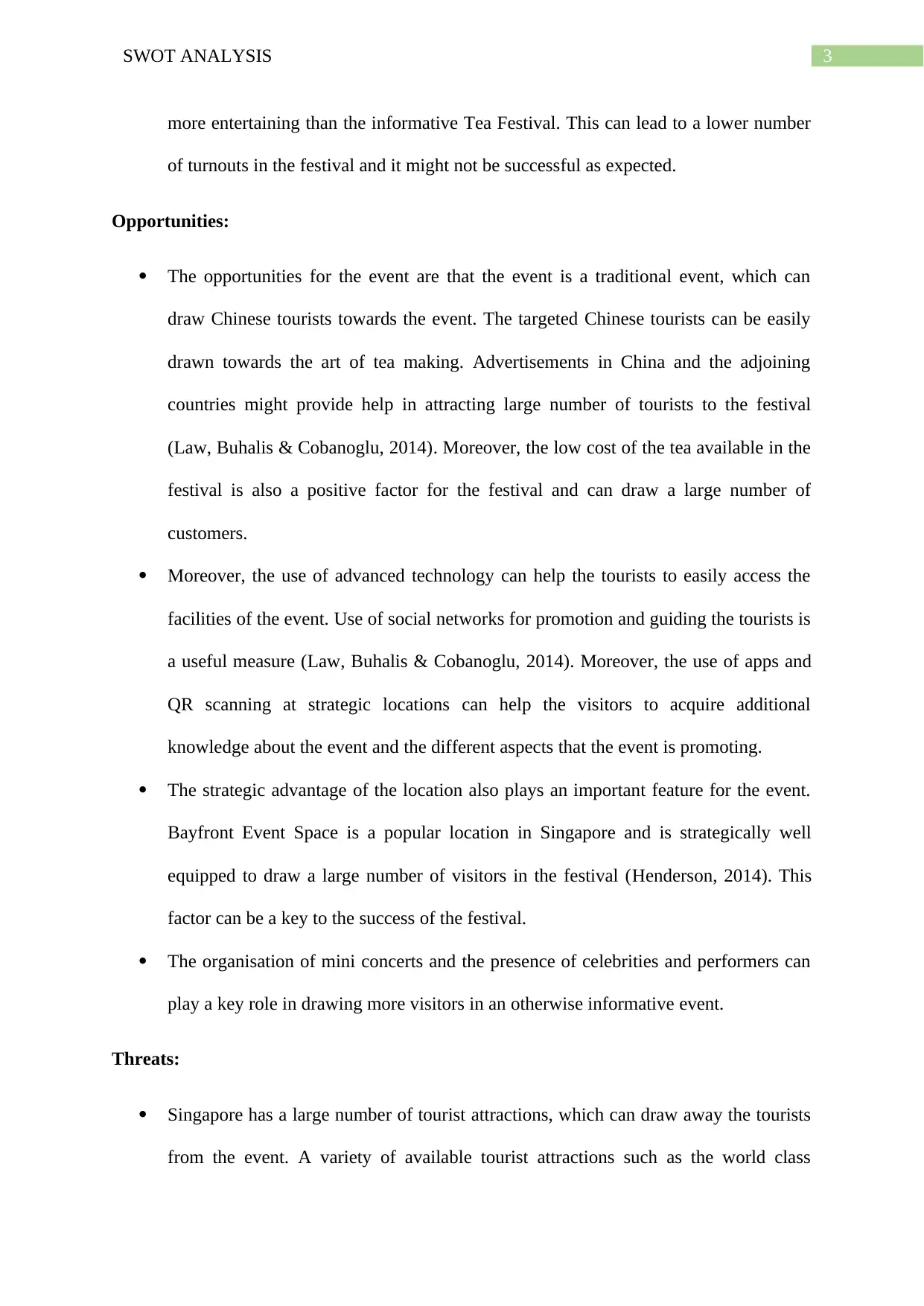
3SWOT ANALYSIS
more entertaining than the informative Tea Festival. This can lead to a lower number
of turnouts in the festival and it might not be successful as expected.
Opportunities:
The opportunities for the event are that the event is a traditional event, which can
draw Chinese tourists towards the event. The targeted Chinese tourists can be easily
drawn towards the art of tea making. Advertisements in China and the adjoining
countries might provide help in attracting large number of tourists to the festival
(Law, Buhalis & Cobanoglu, 2014). Moreover, the low cost of the tea available in the
festival is also a positive factor for the festival and can draw a large number of
customers.
Moreover, the use of advanced technology can help the tourists to easily access the
facilities of the event. Use of social networks for promotion and guiding the tourists is
a useful measure (Law, Buhalis & Cobanoglu, 2014). Moreover, the use of apps and
QR scanning at strategic locations can help the visitors to acquire additional
knowledge about the event and the different aspects that the event is promoting.
The strategic advantage of the location also plays an important feature for the event.
Bayfront Event Space is a popular location in Singapore and is strategically well
equipped to draw a large number of visitors in the festival (Henderson, 2014). This
factor can be a key to the success of the festival.
The organisation of mini concerts and the presence of celebrities and performers can
play a key role in drawing more visitors in an otherwise informative event.
Threats:
Singapore has a large number of tourist attractions, which can draw away the tourists
from the event. A variety of available tourist attractions such as the world class
more entertaining than the informative Tea Festival. This can lead to a lower number
of turnouts in the festival and it might not be successful as expected.
Opportunities:
The opportunities for the event are that the event is a traditional event, which can
draw Chinese tourists towards the event. The targeted Chinese tourists can be easily
drawn towards the art of tea making. Advertisements in China and the adjoining
countries might provide help in attracting large number of tourists to the festival
(Law, Buhalis & Cobanoglu, 2014). Moreover, the low cost of the tea available in the
festival is also a positive factor for the festival and can draw a large number of
customers.
Moreover, the use of advanced technology can help the tourists to easily access the
facilities of the event. Use of social networks for promotion and guiding the tourists is
a useful measure (Law, Buhalis & Cobanoglu, 2014). Moreover, the use of apps and
QR scanning at strategic locations can help the visitors to acquire additional
knowledge about the event and the different aspects that the event is promoting.
The strategic advantage of the location also plays an important feature for the event.
Bayfront Event Space is a popular location in Singapore and is strategically well
equipped to draw a large number of visitors in the festival (Henderson, 2014). This
factor can be a key to the success of the festival.
The organisation of mini concerts and the presence of celebrities and performers can
play a key role in drawing more visitors in an otherwise informative event.
Threats:
Singapore has a large number of tourist attractions, which can draw away the tourists
from the event. A variety of available tourist attractions such as the world class
Secure Best Marks with AI Grader
Need help grading? Try our AI Grader for instant feedback on your assignments.
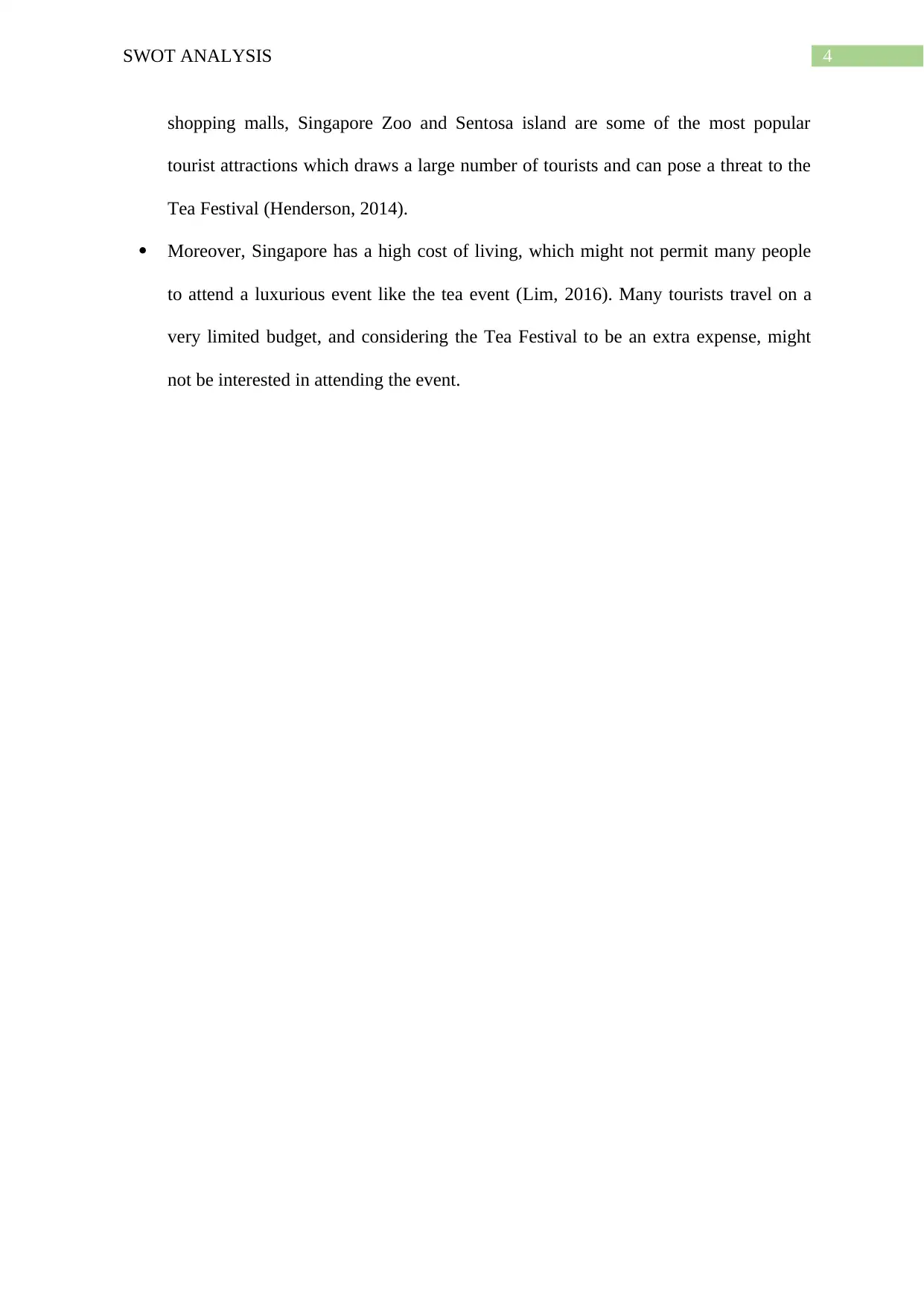
4SWOT ANALYSIS
shopping malls, Singapore Zoo and Sentosa island are some of the most popular
tourist attractions which draws a large number of tourists and can pose a threat to the
Tea Festival (Henderson, 2014).
Moreover, Singapore has a high cost of living, which might not permit many people
to attend a luxurious event like the tea event (Lim, 2016). Many tourists travel on a
very limited budget, and considering the Tea Festival to be an extra expense, might
not be interested in attending the event.
shopping malls, Singapore Zoo and Sentosa island are some of the most popular
tourist attractions which draws a large number of tourists and can pose a threat to the
Tea Festival (Henderson, 2014).
Moreover, Singapore has a high cost of living, which might not permit many people
to attend a luxurious event like the tea event (Lim, 2016). Many tourists travel on a
very limited budget, and considering the Tea Festival to be an extra expense, might
not be interested in attending the event.
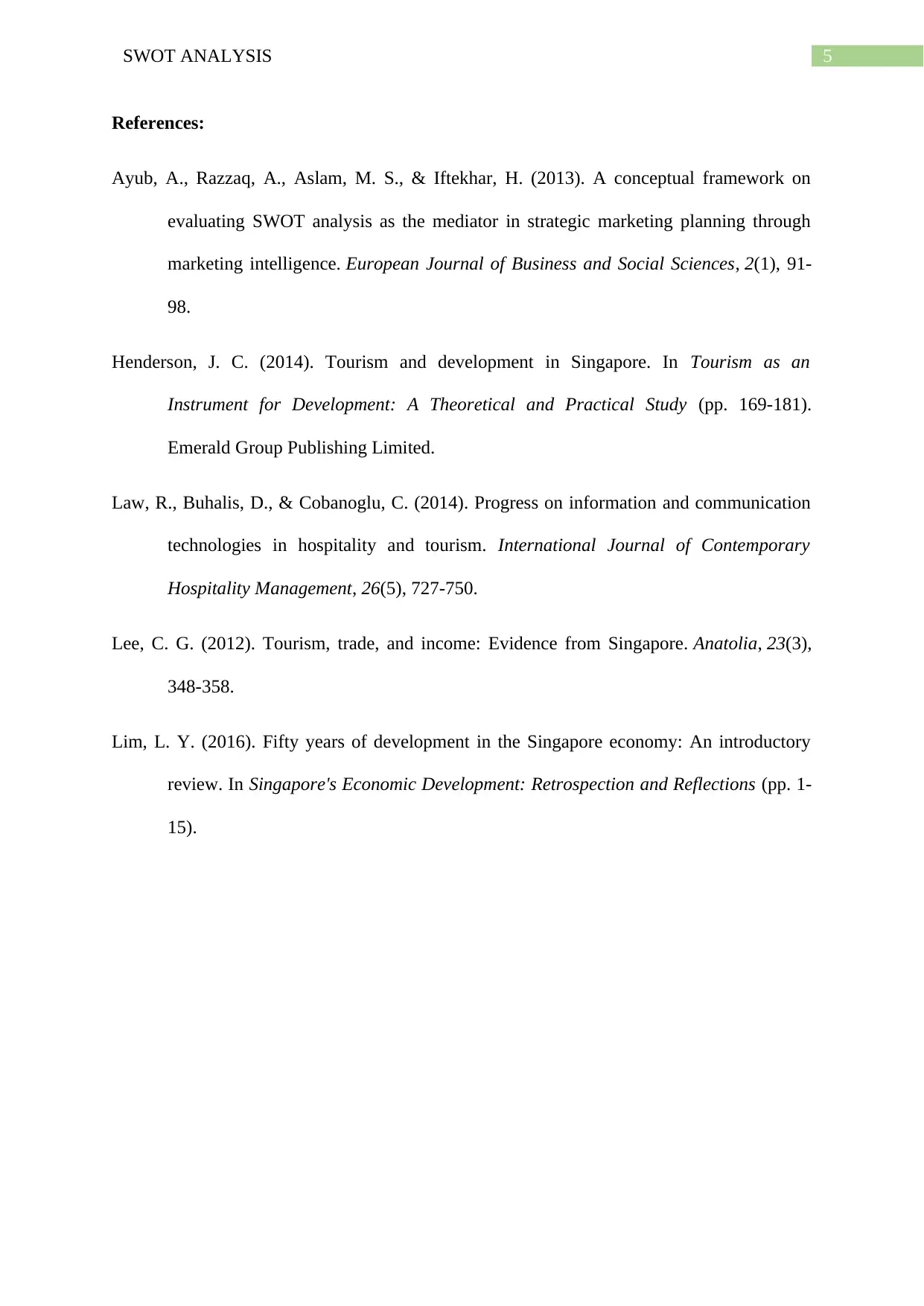
5SWOT ANALYSIS
References:
Ayub, A., Razzaq, A., Aslam, M. S., & Iftekhar, H. (2013). A conceptual framework on
evaluating SWOT analysis as the mediator in strategic marketing planning through
marketing intelligence. European Journal of Business and Social Sciences, 2(1), 91-
98.
Henderson, J. C. (2014). Tourism and development in Singapore. In Tourism as an
Instrument for Development: A Theoretical and Practical Study (pp. 169-181).
Emerald Group Publishing Limited.
Law, R., Buhalis, D., & Cobanoglu, C. (2014). Progress on information and communication
technologies in hospitality and tourism. International Journal of Contemporary
Hospitality Management, 26(5), 727-750.
Lee, C. G. (2012). Tourism, trade, and income: Evidence from Singapore. Anatolia, 23(3),
348-358.
Lim, L. Y. (2016). Fifty years of development in the Singapore economy: An introductory
review. In Singapore's Economic Development: Retrospection and Reflections (pp. 1-
15).
References:
Ayub, A., Razzaq, A., Aslam, M. S., & Iftekhar, H. (2013). A conceptual framework on
evaluating SWOT analysis as the mediator in strategic marketing planning through
marketing intelligence. European Journal of Business and Social Sciences, 2(1), 91-
98.
Henderson, J. C. (2014). Tourism and development in Singapore. In Tourism as an
Instrument for Development: A Theoretical and Practical Study (pp. 169-181).
Emerald Group Publishing Limited.
Law, R., Buhalis, D., & Cobanoglu, C. (2014). Progress on information and communication
technologies in hospitality and tourism. International Journal of Contemporary
Hospitality Management, 26(5), 727-750.
Lee, C. G. (2012). Tourism, trade, and income: Evidence from Singapore. Anatolia, 23(3),
348-358.
Lim, L. Y. (2016). Fifty years of development in the Singapore economy: An introductory
review. In Singapore's Economic Development: Retrospection and Reflections (pp. 1-
15).
1 out of 6
Related Documents
Your All-in-One AI-Powered Toolkit for Academic Success.
+13062052269
info@desklib.com
Available 24*7 on WhatsApp / Email
![[object Object]](/_next/static/media/star-bottom.7253800d.svg)
Unlock your academic potential
© 2024 | Zucol Services PVT LTD | All rights reserved.





